Mengle Temple in Jinghong City, XishuangBanna
Overview
Mengle Temple (勐泐大佛寺), located on the outskirts of Jinghong City (景洪市), the capital of XishuangBanna Dai Autonomous Prefecture (西双版纳傣族自治州), Yunnan Province, is a major tourist destination built to national AAAA-grade scenic area standards. The temple is a reconstruction of the ancient royal temple of the Dai Kingdom, known as Jingpiao Buddhist Temple (景飘佛寺). The original temple was built by King Bolong (拨龙), a historical Dai king, to commemorate his late queen Nansha Weibian (南纱维扁).
The temple was destroyed in the Buddhist year 2883 (equivalent to 1848 AD, during the Qing Dynasty) due to war, leaving it in ruins for 169 years. Mengle Temple began reconstruction in 2005 and officially held the groundbreaking ceremony on March 9th of the same year. During construction, several cultural relics were discovered, including silver coins, silver boxes, and Buddhist ritual items.
Covering an area of 400 acres, the temple sits on a mountain with an elevation difference of 122.8 meters and is uniquely designed to resemble a seated Buddha. The temple integrates the life of Buddha Shakyamuni and Buddhist activities into its architectural and scenic elements, showcasing the history and traditional culture of Theravada Buddhism.
Key Information
- Chinese Name: 勐泐大佛寺
- Location: Mannongfeng (曼弄枫), Jinghong City, XishuangBanna (景洪市, 西双版纳)
- Opening Hours: Open year-round from 8:00 AM to 6:00 PM (latest entry at 5:30 PM)
- Attraction Level: National AAAA-rated scenic area
- Ticket Price: 120 RMB per person
- Area: 400 acres
- Famous Attractions: Jingpiao Hall (景飘大殿), Auspicious Buddha (吉祥大佛), Zhuangkai Golden Stupa (庄凯大金塔)
- City: Jinghong, XishuangBanna, Yunnan Province, China
- Suggested Visiting Time: 1-2 hours
- Best Time to Visit: All year round
Mengle Temple is located in the suburbs of Jinghong City, Xishuangbanna Dai Autonomous Prefecture, Yunnan Province, and is developed according to the national AAAA scenic area standards. Mengle Temple is a restoration of the ancient Dai royal temple “Jingpiao Temple,” which was originally built by a Dai king named Bolong in memory of his deceased queen, Nanshayi Bian.
The temple was destroyed during a war in the Buddhist year 2883 (1848 AD, during the Qing Dynasty’s Xianfeng period), which was 169 years ago. The reconstruction of Mengle Temple began in 2005, with a grand land consecration ceremony held on March 9 of the same year, followed by the foundation laying ceremony for the main hall on May 9, 2005. During the construction of the main hall, a large number of silver coins, silver boxes, and Buddhist ceremonial items were unearthed.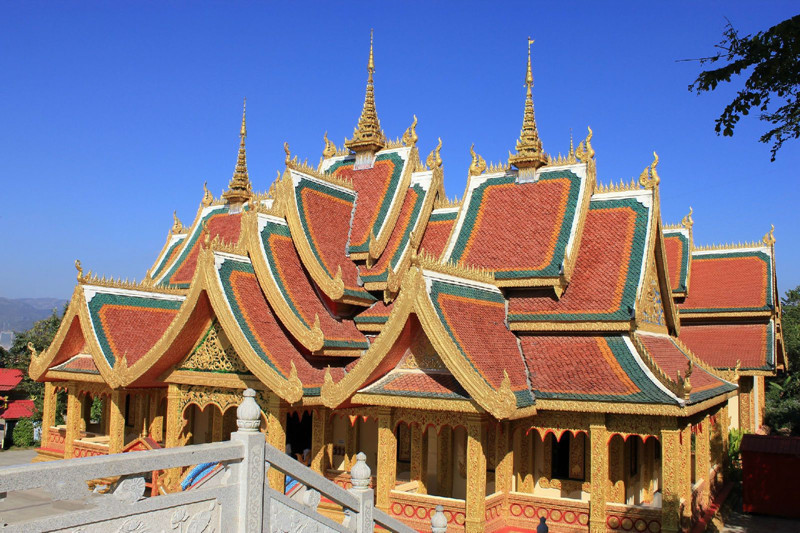
Mengle Temple covers an area of 400 acres, built against the mountain with a height difference of 122.8 meters, forming a unique sitting Buddha shape. It integrates the life of the Buddha, Shakyamuni, and temple activities into the landscape and architectural complex, showcasing the history and traditional culture of Theravada Buddhism.
History
Mengle Temple occupies a total area of 650 acres, with a construction area of 24,000 square meters. It represents a major cultural site aimed at promoting the legacy of Theravada Buddhism (南传佛教). The scenic area integrates traditional and modern elements to fulfill the modern-day tourist’s demand for historical, religious, and cultural experiences.
The original temple, Jingpiao Buddhist Temple (景飘佛寺), was a significant religious site built during the Ming Dynasty to honor the Theravada Buddhist traditions of the Dai people and the royal family. The Dai King Bolong built the temple to remember his beloved queen, who passed away during her youth. Due to her devout belief in Buddhism, the king frequently held grand religious ceremonies at the temple to both honor his queen and propagate Buddhist teachings.
The ancient temple was a vital landmark for the 12 Banna regions, playing an essential role in Buddhist activities in the area.
“Xishuangbanna Mengle Temple” is situated from the end of Highway No. 1 in Jinghong City to Nalian Mountain, covering an area of 650 acres, with a building area of 24,000 square meters and a total investment of about 200 million yuan. It is built according to national AAAA scenic area standards. The scenic area focuses on promoting “Theravada Buddhist culture,” using modern methods to inherit traditional culture and meet the modern tourists’ needs for experiencing history, Buddhist culture, and regional culture.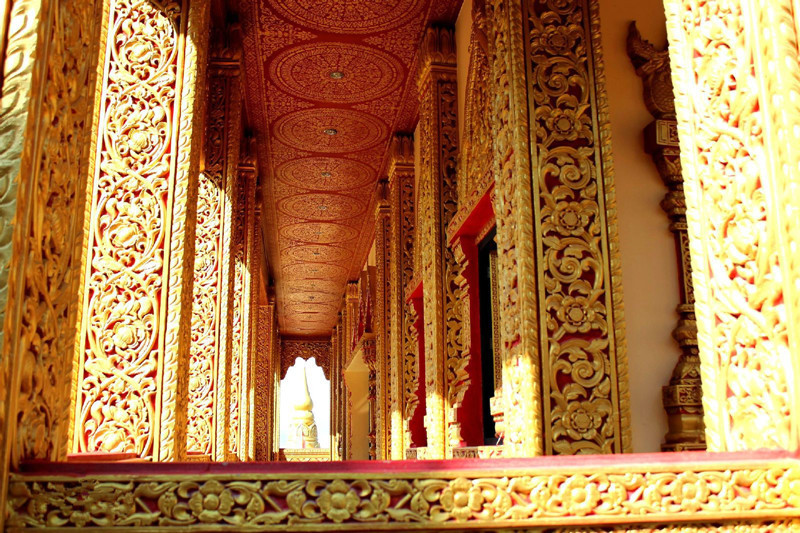
Architectural Features
The design of Dai Buddhist temples in XishuangBanna showcases the unique and intricate architecture of the region. The temples are predominantly rectangular in shape with multi-layered, sloping roofs. The temple roofs are made of rectangular tiles hooked onto bamboo beams and feature ornately decorated ridges.
Interior of Mengle Temple
The temple hall houses a large statue of Buddha Shakyamuni (释迦牟尼). The Buddha is often depicted in a seated position with large, distinctive ears, reflecting traditional Dai artistic style. His serene expression and elegant features embody the tranquility and mystery of the ancient Dai history.
The surrounding stupas are equally ornate, with intricately carved phoenixes and other symbolic designs. The entrance pavilion of the stupa is particularly impressive, featuring a double-eaved roof supported by columns without walls, allowing for an open and airy passage.
Social Impact
Theravada Buddhism has had a profound impact on Dai society, influencing its politics, economy, and cultural arts. Many of the Dai people’s long epic poems were developed after the introduction of Buddhism. The Pali Canon has been extensively recorded on palm leaf manuscripts (贝叶经), preserving the Buddhist teachings.
In XishuangBanna, nearly every village has a Buddhist temple, with over 500 temples and 200 stupas scattered across the region. Mengle Temple is the most prominent of all, serving as a spiritual hub and a cultural treasure for the Dai people.
The significant characteristics of Dai architecture are evident here, with no pillars embedded in the walls. Most buildings feature pagodas, including Burmese-style bell-shaped pagodas, pavilion-style pagodas, Thai Vajrasana pagodas, and octagonal eaves pagodas, all showcasing diverse forms. These pagodas are mainly constructed from bricks, covered with lime and paint, and are mostly solid. The Manfeilong Pagoda in Jinghong City is a Thai-style Vajrasana pagoda, designed by three Indian Buddhist missionaries and constructed under the direction of a Dai leader in 1204 AD, making it over 800 years old.
The base of the Mengle Temple pagoda is shaped like a plum blossom, with a circumference of 42.6 meters and a main tower height of 16.29 meters, surrounded by eight small towers, each 9.1 meters high, distributed in an octagonal layout. Each small tower contains a niche with a clay sculpture of a phoenix soaring in mid-air. The entire group of towers is pristine and beautiful, making it a key national cultural relic protection unit and a popular tourist destination.
The temple is built on the original site of “Jingpiao Temple,” a royal temple of the ancient Dai dynasty, constructed by King Bolong in memory of his deceased queen, who devoted her life to Buddhism. Therefore, every holiday, the Dai king would visit the temple to hold large ceremonies in her memory and to promote the teachings of Buddhism. Historical records indicate that “Jingpiao Temple” was established during the Ming Dynasty and is one of the symbolic buildings representing Theravada Buddhism in Xishuangbanna, also serving as an important venue for Buddhist activities.
Buddhist Tradition
The Dai people of Xishuangbanna predominantly practice Theravada Buddhism, which initially spread from India southward to Sri Lanka and then to Southeast Asian countries such as Myanmar, Thailand, Cambodia, Laos, and the Dai people in Yunnan, China. This branch of Buddhism is also known as “small vehicle” Buddhism. Due to its reliance on Pali as the canonical language, it is sometimes referred to as “Pali Buddhism.” The various sects within small vehicle Buddhism include the Mahāsāṃghika, Theravāda, Sarvāstivāda, and Sautrāntika.
Mengle Temple belongs to the Theravāda sect, which is prevalent in southern and eastern India; the Sarvāstivāda sect is found in northwestern, central, and western India; and the Sautrāntika sect has spread to Sumatra, Java, and is also found in central Vietnam. The fundamental teachings of small vehicle Buddhism are based on the “Four Noble Truths” (Dukkha, Samudaya, Nirodha, and Magga), asserting that life is characterized by suffering, advocating for self-liberation, and the pursuit of nirvana through good deeds and the accumulation of merit.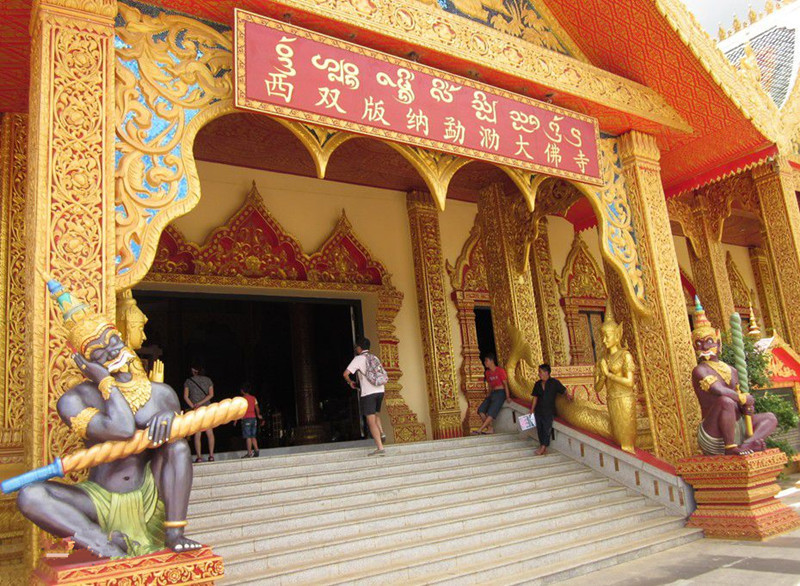
Architecture and Design
The architecture of Mengle Temple reflects the distinct style of Dai architecture, which is characterized by free-standing columns that do not penetrate the walls. The temple complex features various Buddhist stupas, including:
- Burmese-style bell-shaped stupas (缅式钟形佛塔)
- Pavilion-style stupas (亭阁式佛塔)
- Thai-style vajra stupas (泰金刚座佛塔)
- Octagonal stupas with multi-layered eaves (八角形密檐佛塔)
Most of the stupas are constructed from brick, covered with plaster, and painted, with many being solid structures. One of the most notable stupas in Jinghong is the Manfeilong Stupa (曼飞龙佛塔), a Thai-style vajra stupa. This towering structure, resembling a bamboo shoot, was designed by three Indian Buddhist missionaries and constructed in 1204 AD. It has stood for over 800 years.
The Mengle Temple Stupa Complex
The stupa complex at Mengle Temple is designed in a plum blossom (梅花状) shape, with a perimeter of 42.6 meters. The main stupa stands at a height of 16.29 meters and is surrounded by eight smaller stupas, each 9.1 meters tall, arranged in an octagonal pattern. The stupas are multi-tiered with gourd-shaped structures, and inside each small stupa is a shrine housing a clay phoenix sculpture. The entire stupa complex is pristine white, creating a stunning and elegant sight.
This site is also a nationally protected cultural relic and a popular tourist attraction.
Theravada Buddhist Tradition
Most of the Dai people in XishuangBanna practice Theravada Buddhism (南传上座部佛教). This form of Buddhism originated in India and spread through Sri Lanka, Myanmar, Thailand, Cambodia, Laos, and parts of Yunnan. Also known as Hinayana Buddhism (小乘佛教), it relies on the Pali Canon as its scriptural basis and emphasizes personal salvation through rigorous self-discipline.
Key Doctrines
The core doctrines of Theravada Buddhism are the Four Noble Truths (四谛):
- Dukkha (苦谛) – The truth of suffering
- Samudaya (集谛) – The cause of suffering
- Nirodha (灭谛) – The cessation of suffering
- Magga (道谛) – The path leading to the cessation of suffering
The teachings advocate self-liberation and reaching nirvana by practicing virtuous deeds and accumulating merit through meditative practices.
Layout and Structure
The Theravada Buddhist monks in Xishuangbanna are mainly divided into three ranks: “Pa” (novice), “Du” (bhikkhu), and “Huba” (elder). Boys are sent to the temple by their parents at the ages of 7 or 8 to learn scriptures and prepare as novices. After learning the required scriptures, they are initiated as monks on an auspicious day. Once a novice reaches 20 and wishes to remain a monk, he can apply for promotion to “Du,” and after reaching 30, he may be promoted to “Huba” if he wishes to dedicate his life to monasticism.
Dai Buddhist Architecture
Small vehicle Buddhism was introduced to Yunnan’s Xishuangbanna hundreds of years ago and has become the predominant faith among the Dai people. Buddhist temples are ubiquitous, with almost every village having one or two, often accompanied by stupas. These temples and stupas serve as central gathering places for the Dai community and are considered sacred by the people, representing valuable cultural and artistic heritage.
Architectural Style
Dai Buddhist temples in Xishuangbanna predominantly feature a heavy eave and multi-slope tiled roofing style. The temples are generally square, facing east, with three overlapping layers on the roof. The middle hall is higher, while the eastern and western sides gradually decrease. The roofs are covered with rectangular tiles, with the edges hooked onto bamboo purlins.
The ridge between the roof and the eaves is smoothed with lime, and various tile decorations are arranged on top. The ridge decorations are flame-shaped, with phoenix images often adorning the ends of the eaves. The interiors of the temple’s halls consist of a Buddha seat, monk seats, and scripture platforms. The statue of Shakyamuni Buddha is predominantly seated, with distinctively large and wide ears, a slender figure, and a serene expression that evokes curiosity about Dai history.
The entrance pavilion to the stupa features a unique design, built with a double-eave gable roof and an angled roof connecting to create an entrance structure supported only by columns, with no walls, allowing free movement.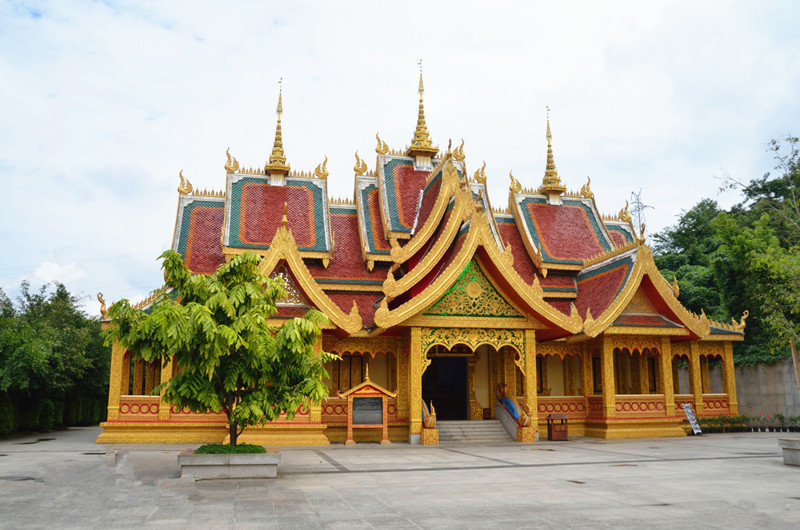
Social Impact
Theravada Buddhism has profoundly influenced the political, economic, cultural, and artistic aspects of Dai society. Many of the long narrative poems of the Dai were created after the introduction of Buddhism. The Dai Canon, known for its extensive collection of over 84,000 texts, is primarily inscribed on palm leaves.
The Dai people of Xishuangbanna generally expect boys to enter the monkhood at ages 8 to 10, where they live a monastic life, learning scriptures and literacy, typically returning home after 1 to 5 years. During important festivals such as the Water-Splashing Festival and the Gate Closing Festival, Dai families visit temples to pay respect to the Buddha.
In Xishuangbanna, temples are found in almost every village, with unique architectural styles. Today, there are over 500 temples and more than 200 stupas in the Dai villages of Xishuangbanna, with Mengle Temple being the largest and most significant, revered as a holy site among the Dai people.
The temple is presided over by the chief monk of the southern Theravada Buddhist community, Huba Longzhuang Meng.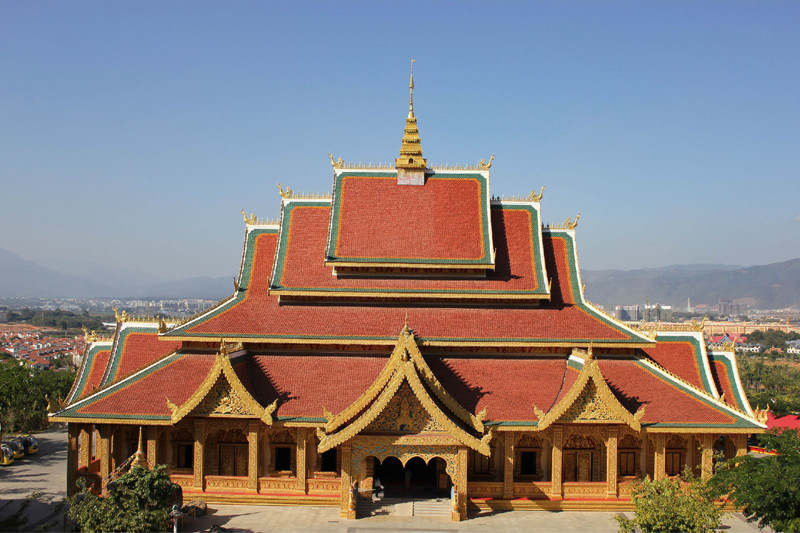
Tourist Information
Admission: The price for the incense and flower ticket is 120 yuan per ticket, with an online booking price of 108 yuan (not including in-park transportation). The one-way in-park transportation fee is 40 yuan per person, and the round-trip fee is 60 yuan. Children between 1.2 and 1.4 meters in height, full-time students with student ID cards, and people aged 60 to 70 with ID can receive a discount (80 yuan per ticket), excluding major ceremonial events. Children under 1.2 meters in height, those over 70 years old, people with disabilities, active military personnel with service IDs, and licensed tour guides in Xishuangbanna can enter for free (excluding major ceremonial events).
Opening Hours: 8:00 AM – 5:30 PM; the “Bathing the Buddha” water-splashing activities take place at 2:00 PM and 4:00 PM daily. The peacock release activity occurs five times daily at 9:30 AM, 11:00 AM, 1:30 PM, 3:00 PM, and 5:00 PM.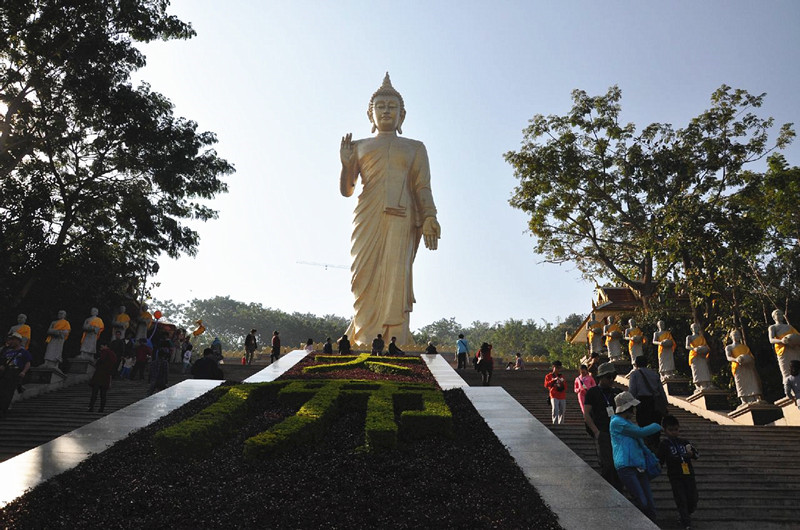
How to Get There
Mengle Temple is located in the southern part of Jinghong City, on Nanlian Mountain (南莲山), and can be reached easily by car, bus, or taxi:
- From Jinghong City Center: Take bus line 1 directly to the temple, or hire a taxi, which will take approximately 15 minutes.
- From XishuangBanna International Airport: A taxi ride takes around 25 minutes.By Car: From Jinghong City, take Garlan Middle Road, Xuanwei Avenue, Daxing Times Square, and Mengle Avenue to the destination.
By Taxi: Mengle Temple is located 4 kilometers from Jinghong City, and a taxi ride costs about 15 yuan.
Travel Tips
- Ticket Price: General admission is 120 RMB. Discounts are available for students and seniors.
- Best Time to Visit: While Mengle Temple is open year-round, visiting during major Buddhist festivals like the Water-Splashing Festival (泼水节) will allow you to experience unique cultural and religious ceremonies.
- Dress Code: As it is a sacred site, visitors are advised to dress modestly.
- Tour Duration: Plan to spend 1-2 hours exploring the temple grounds.
- Additional Services: Shuttle services are available inside the temple for a fee (40 RMB one-way, 60 RMB round-trip).
Make sure to explore the Jingpiao Hall (景飘大殿) and the towering Auspicious Buddha (吉祥大佛), both key highlights of the temple complex.
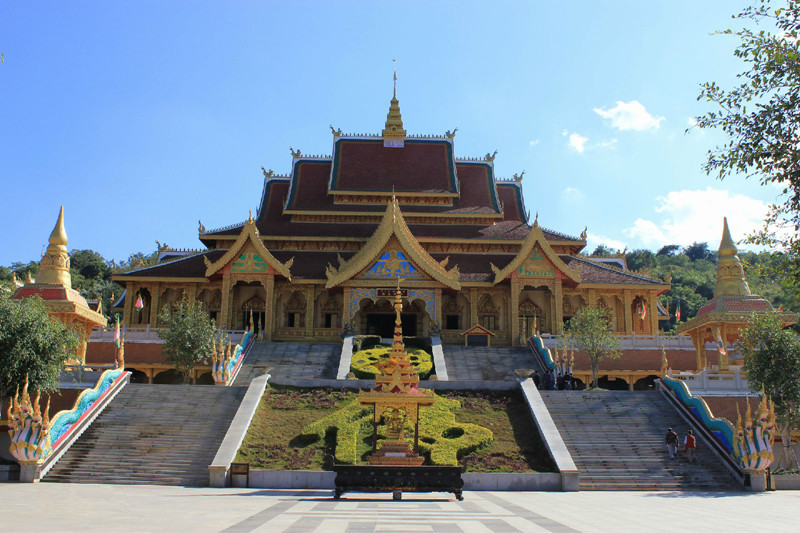
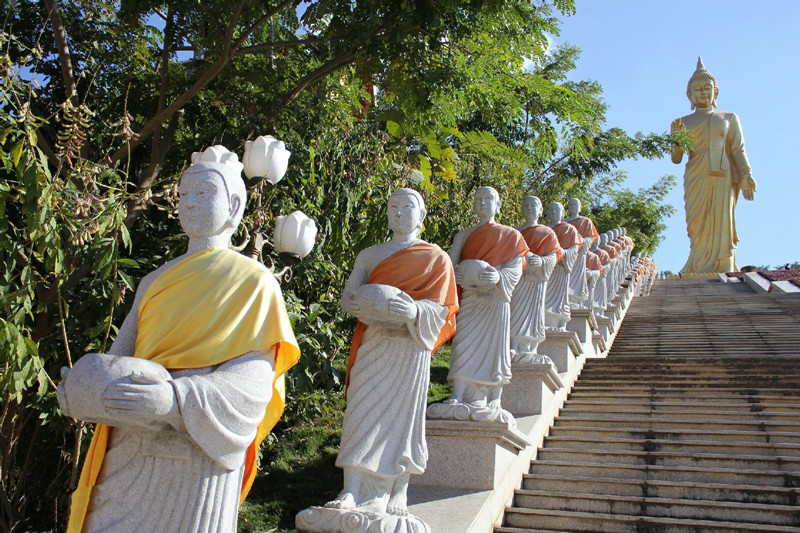

 7 Days GolfingTour
7 Days GolfingTour
 8 Days Group Tour
8 Days Group Tour
 8 Days Yunnan Tour
8 Days Yunnan Tour
 7 Days Shangri La Hiking
7 Days Shangri La Hiking
 11 Days Yunnan Tour
11 Days Yunnan Tour
 6 Days Yuanyang Terraces
6 Days Yuanyang Terraces
 11 Days Yunnan Tour
11 Days Yunnan Tour
 8 Days South Yunnan
8 Days South Yunnan
 7 Days Tea Tour
7 Days Tea Tour
 8 Days Muslim Tour
8 Days Muslim Tour
 12 Days Self-Driving
12 Days Self-Driving
 4 Days Haba Climbing
4 Days Haba Climbing
 Tiger Leaping Gorge
Tiger Leaping Gorge
 Stone Forest
Stone Forest
 Yunnan-Tibet
Yunnan-Tibet
 Hani Rice Terraces
Hani Rice Terraces
 Kunming
Kunming
 Lijiang
Lijiang
 Shangri-la
Shangri-la
 Dali
Dali
 XishuangBanna
XishuangBanna
 Honghe
Honghe
 Kunming
Kunming
 Lijiang
Lijiang
 Shangri-la
Shangri-la
 Yuanyang Rice Terraces
Yuanyang Rice Terraces
 Nujiang
Nujiang
 XishuangBanna
XishuangBanna
 Spring City Golf
Spring City Golf
 Snow Mountain Golf
Snow Mountain Golf
 Stone Mountain Golf
Stone Mountain Golf
















It is easy to understand. High quality pictures.Peasant website. – Palitha Mahinda from Sri Lanka Could you send me a contact e-mail address of Mengle Temple of Jionghong city proper, Xishuangbanna Dai Autonomous Prefecture.
Sorry, we don’t have it.
The address of Mengle Temple in Jinghong City, Xishuangbanna Dai Autonomous Prefecture, Yunnan Province, China is:
Mengle Temple (勐泐大佛寺)
Xishuangbanna Scenic Area,
Jinghong City,
Xishuangbanna Dai Autonomous Prefecture,
Yunnan Province, China
It’s located within the Mengle Cultural Park, which is a significant cultural and religious site in the region. The temple is easily accessible from the city center of Jinghong.